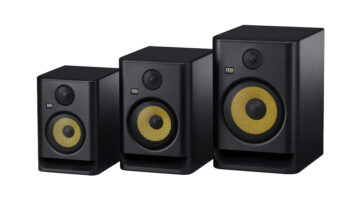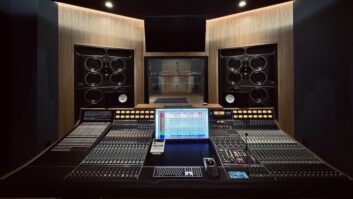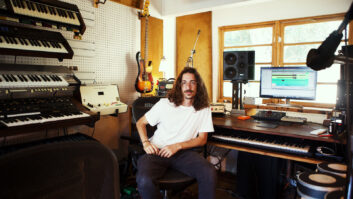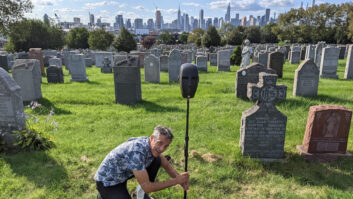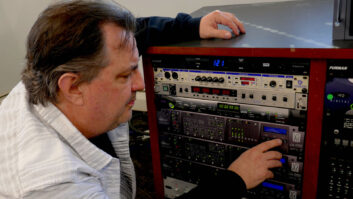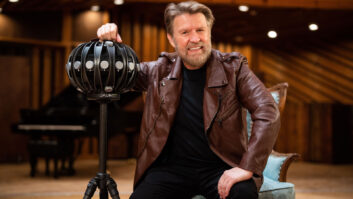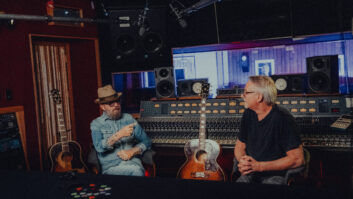
Roger Waters’ revival of The Wall sports a 100-foot-long, 35-foot-high cardboard wall that is built,
brick by brick, between the audience and band during the first half of the show.
By Clive Young.
The mood is serious. On this cool fall afternoon, crews are rushing to shoehorn a massive production into the aged Nassau Coliseum in Uniondale, NY, the tour in question being Roger Waters’ signature work, Pink Floyd’s The Wall—the bleak 1979 concept album of rock-star narcissism and isolation.
Inside Nassau, the ceiling is low compared to more modern venues, so the projection rig is taking longer to line up, and the quadraphonic speakers hang a tad lower than usual. Meanwhile, up on stage, the namesake 100-foot-wide, 35-feet-tall Wall is still being test-built so that it can be taken down again, just in time for doors to open. Amidst the flurry of urgent activity is Waters himself, dressed in stark black, surveying the scene from the stage post-soundcheck.
Vocals are all captured via Shure SM58 mics.
And he’s dancing.

Turns out every day, Waters teaches a simple sidestep-clap disco move to local teens who come on stage during “Another Brick in the Wall” to perform the routine before pointing defiant fingers at a giant inflatable Teacher intent on crushing their very souls. It should be noted at this juncture that the artist who envisioned some of the darkest musical works in rock history is currently laughing away, high-fiving the kids and generally having a blast. The choreography lesson is a bit surreal to watch, to be sure, but it’s also rather sweet.
It’s quite appropriate, too, because as the cliché goes, time changes everything. In the intervening 30 years, Waters has come to re-envision The Wall as “an allegory for broader concerns: nationalism, racism, sexism, religion, whatever,” he notes in the tour program. Likewise, when Pink Floyd toured The Wall three decades ago, the ambitious production—sporting a giant wall built between band and audience during the show, only to be knocked down at the cathartic finale—was so complicated that it only played two venues in North America, one of them being Nassau Coliseum. Since then, tour technologies have advanced so far that while the new Wall production is more complex than ever, it will have played over 50 shows at more than 35 venues by the time the U.S. leg finishes later this month.
Helping make that happen is a Clair (Lititz, PA) audio system, overseen by tour manager/sound engineer Trip Khalaf, who mixes the show nightly using a pair of Midas XL4 consoles supplemented by a Yamaha PM5D. Even with a dozen musicians on stage, that might seem like a lot, but it’s also necessary; one XL4 handles the band on the main stage while the other does the same thing during the second half of the show, when the group plays four songs on the forestage—the area in front of the completed Wall. Meanwhile, the PM5D’s automation is used for effect returns and surround playback.
“The way we approach surround with Roger is not for it to be a 5.1, ‘put you in the middle of the band playing’-type thing,” says system engineer Bob Weibel. “It’s almost exclusively for playback of pre-recorded sound effects, although at one small part of the show, a live organ gets panned around amongst the surrounds, which are three clusters of 16 Clair R-4 cabinets.”
The main PA is comprised of prototype Clair i-5Ds, which incorporate the waveguide from the i-5 and the midrange waveguide from the i-5 in a larger cabinet with two 18s. “We’re still developing it,” says Weibel. “It’s been working out well so far, but we still have additional ideas about how we can get it to perform even better.” Powering the system are Crown power amplifiers, with Powersoft amps driving the subs.
It would be fair to expect that the construction of the giant Wall could create plenty of audio issues, but that hasn’t been the case. The PA hangs comfortably above the edifice, covering right up to the front row without obstruction, while smaller Clair FF-2 front fill cabinets and a dozen BT-218 subs warm up the front two rows.
The Wall itself is constructed almost entirely with large, white cardboard “bricks” that slot into each other to ensure stability and a flat surface for video projection, though a few lightweight steel frames are interwoven, used to reveal the band on stage while construction continues above the musicians.
VITAL STATS
The Wall
Clair (Lititz, PA)
FOH Engineer/Tour Manager:
Trip Kalaf
Monitor Engineer:
Robin Fox
Systems Engineer:
Bob Weibel
Ast. Monitor Engineer:
Kevin Kapler
Techs:
Henry Fury, James Higgins,
Matt Scoggins
FOH Console:
(2) Midas XL4, (1) Yamaha PM5D
Monitor Console:
DiGiCo SD7
House Speakers:
Clair i-5D, i-5, FF-2, BT-218,
R-4 Series III
Monitor Speakers:
Clair 12AM Series II, ML-18
Personal Monitors:
Sennheiser EK 2000; Shure PSM 600;
JH Audio
House Amplifiers:
Crown; Powersoft
Monitor Amplifiers:
Clair StakRak (Lab.gruppen PLM)
FOH Equipment:
Crane Song STC-8; Aphex; dbx 900;
Lexicon 480L; TC Electronic;
Summit TLA-100
Microphones:
Shure SM58, Beta52, SM57, SM91,
UR; Audio-Technica AT4050;
Audix D2; MiLab DC-96;
Sennheiser MD421; Countryman DI
Monitor engineer Robin Fox, who was an audio assistant on the first Wall tour, explains, “When I did it in 1980, we were out in L.A. and Roger went, ‘Wait a minute. Can’t you build it any slower?’ Well no, otherwise we’ll never get to the top by the time you want it. ‘Oh, OK.’ So they had to work out frames so that there’s little gaps to see in.”
All that cardboard does little to absorb or reflect the house audio; sound in the crowd is as clear and thunderous as any other rock show. One place where the Wall does affect sound, however, is onstage and in Fox’s adjacent monitorworld. “When they start, you’re quite close to the PA, so you feel that; then when they build the Wall, suddenly you’re in a club—a 100-foot-wide club with an acoustic shield in front of it,” he says.
The monitor mix position centers around a DiGiCo SD7 console with a channel count of 144—48 monos, 18 stereos, one group bus, 32 matrix inputs, 16 matrix outputs and 24 control groups. Fox chose the desk for its flexibility, explaining, “Roger’s constantly creative, always looking for a different way of doing things, so the show is always evolving. If he asks you for something, you want to be able to give it to him; you don’t want to be behind in the game, and that’s what I found I can do with the DiGiCo SD7—there’s a lot of facility there.”
A good number of those inputs come from the relatively conventional miking, with Shure SM58s used for vocals; electric guitars captured by Audio-Technica AT4050s; a selection of Shures, Audixes and MiLabs on the drums; and Countryman DIs on the keyboards, excepting two remote Leslie cabinets under the deck heard via Sennheiser MD421s.
While wedges are on hand to provide some feel, the band mainly hears cues and itself via Sennheiser wireless systems with ear pieces from JH Audio: “Chris Kansy, our production manager, knew Jerry Harvey, so we went to them and its been tremendous service, right from the first phone call. They return calls and e-mails, they say, ‘Let’s try this,’ and if they send something, it’s at the hotel or the venue the next day, not ‘Oh, where did that go?’”
Between the cardboard wall and low-key monitoring, it’s a relatively quiet stage; as Fox jokes, “The stage volume is actually quite low; you could have a conversation after the Wall is built, because the audience can’t see you.” Asked if that makes for a more relaxed atmosphere once the Wall is completed, Fox laughs. “The concentration on this show is incredible!” he responds. “Everybody wants to be at the top of their game; nobody’s in a hammock waiting to be called. Something else I’ve observed as well is everyone is helping out—lighting guys helping the carps, security guys carrying bits of setup, backline guys helping with the floor lights.”
The cooperative spirit runs to all corners of the production, inspiring admiration among the crew. “These carpenters work very hard,” Fox continues. “They’re marking the floor at 2:30 in the morning, 4:30 is full production load-in. They will be in show blacks in a bit, out here with a flag at the top of the show on the stage; it’s near a 24-hour day. Towards the end of the month, they’ve got to do shows back to back, and these boys instead of complaining about it, they want to be the carpenters who did 22 trucks—The Wall!— back to back. Nobody’s ever done it.”
In the decades after The Wall album was released, music grew smaller in the real world, shrinking from big double-LP sets to CDs to cassettes until it vanished into the ether, taking the incorporeal form of MP3s. As a result, to watch The Wall live today and experience music manifested on such an epic, physical scale is all the more breathtaking. Simply put, it floors the crowd night after night, and that, in turn, imbues the crew with the satisfaction of a job well done. “I’m thrilled and proud to be associated with this production,” says Weibel. “Lots of hard work and lots of long hours—but you get something you can really be proud of at the end.”
Clair
www.clairglobal.com
DiGiCo
digiconsoles.com
JH Audio
jhaudio.com
